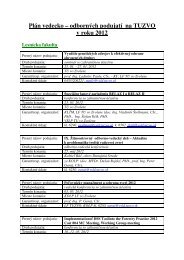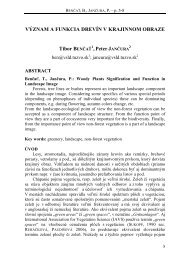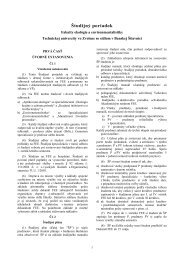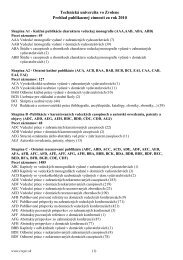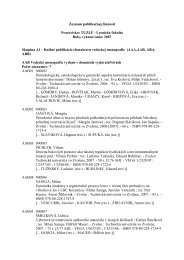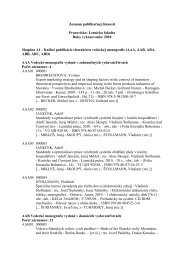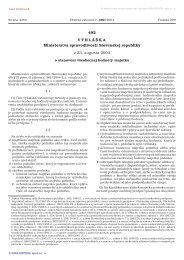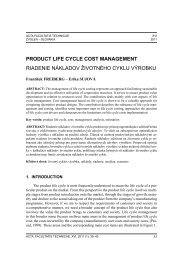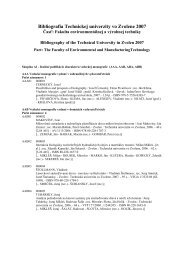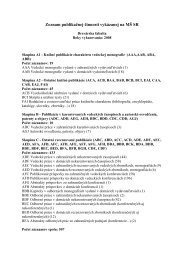Acta Facultatis Ecologiae - Technická univerzita vo Zvolene
Acta Facultatis Ecologiae - Technická univerzita vo Zvolene
Acta Facultatis Ecologiae - Technická univerzita vo Zvolene
- No tags were found...
Create successful ePaper yourself
Turn your PDF publications into a flip-book with our unique Google optimized e-Paper software.
33ACTA FACULTATIS ECOLOGIAE, 16: Suppl. 1, 33 – 36 Z<strong>vo</strong>len (Slovakia), 2007POSTIRRADIATIONAL CHANGES IN HEMATOLOGICPARAMETERS AND IN INTESTINAL MICROFLORA IN RATSKatarína Beňová 1 – Katarína Strišková 1 – Petr D<strong>vo</strong>řák 21University of Veterinary Medicine, Komenského 73, 041 81 Košice, Slovak Republic, e-mail: benova@uvm.sk2University of Veterinary and Pharmaceutical Sciences, Palackého 1–3, 612 42 Brno, Czech Republic,e-mail: d<strong>vo</strong>rakp@vfu.czABSTRACTBeňová K., Strišková K. & D<strong>vo</strong>řák P. Postirradiational Changes in Hematologic Parameters and inIntestinal Microflora in RatsA decrease in the defense capacity of the body combined with penetration of intestinal microorganismsthrough the intestinal wall causes severe, often lethal complications of the acute radiation disease. We followedthe clinical symptoms, the changes of hematological parameters and the changes of the compositionof intestinal microflora in laboratory rats irradiated by a single, whole–body dose of 15 Gy gamma-rays.An increase of the common microflora in duodenum, liver and in oral cave and leucopoenia in peripheralblood have been observed in all time intervals followed. The changes in red blood cells were characterizedby anemia, manifesting clinically in hemorhagies and bloody diarrhea.Key words: ionizing radiation, clinical symptoms, hematological changes, microflora, ratsINTRODUCTIONThe wide use of nuclear technologies in variousareas of human activities made necessary towork out methods of radioprotection. Therefore, itis important to know the detailed mechanisms ofthe biological action of radiation and that of thepathogenesis of radiation disease. Up to now a hugeamount of knowledge about the radiation effectson living organisms have been accumulated, buta unifying theory of their mechanisms is still lacking[1, 2].Post-irradiational changes in peripheral bloodand in hematopoesis in mammals and birds are oftenfollowed in literature [7, 9, 14]. The evaluationof these changes belongs to the basic diagnosticmethods of the radiation disease. Based on clinicalsymptoms, hematological parameters and changesin microflora the severity of radiation disease andthe prognosis of pathogenesis could be estimated.The aim of our work was to investigate thechanges in hematological parameters and in intestinalmicroflora in rats irradiated with a supralethaldose of gamma-rays and observe the dynamics ofoverall clinical symptoms during 9 days after irradiation.MATERIAL AND METHODSMale Wistar rats, aged 3 months were used inthe experiments. Before the experiment, the animalswere kept for 1 week in a previously disinfectedroom to acclimatize to experimental conditions[5]. They were housed in plastic cages on woodshavings at 22–24 o C and 65 % relative humidity ofair. The animals had a free access to pelleted standardfood and tap water [13].After the adaptation period the rats were irradiatedby a single whole-body dose 15 Gy of gamma-raysfrom a 60 Co-source (irradiation apparatusCHISOSTAT, Chirana, Prague, Czech Republic)by a dose rate of 0.117 Gy.min –1 . The animals werethen divided into experimental groups (n = 6),analyzed 3, 6 and 9 days after irradiation. Fromanimals fasting overnight a swab of the oral mucuswas taken, then they were sacrificed by fast



